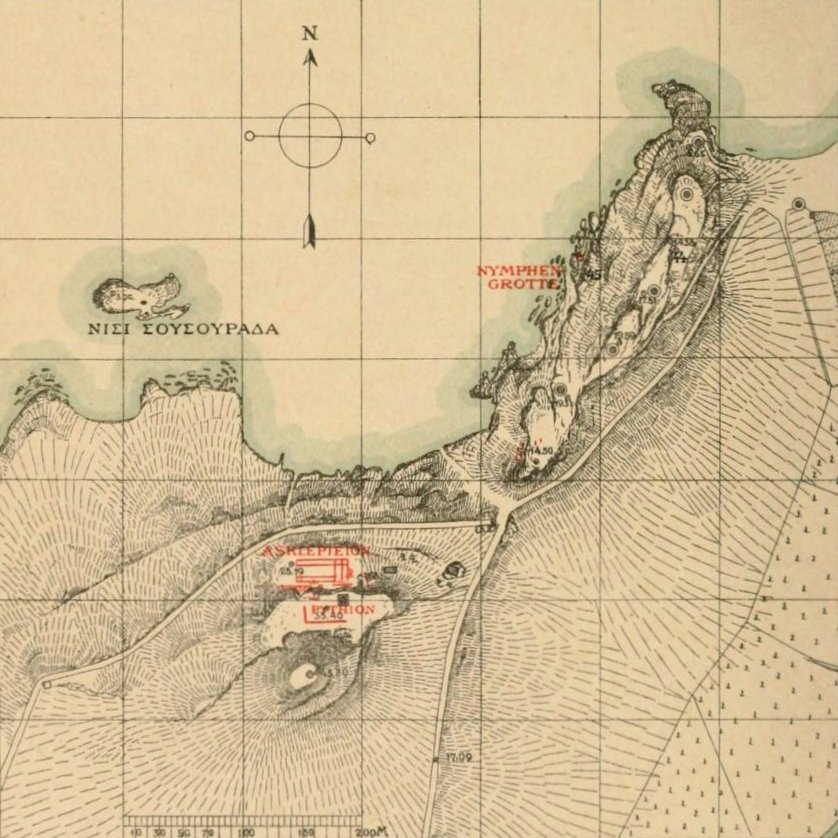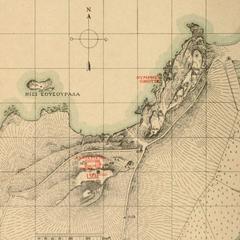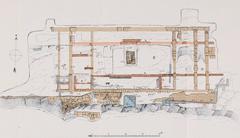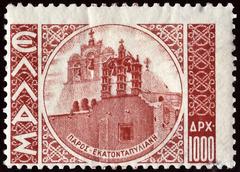
Asclepeion of Paros: Visiting Hours, Tickets & Travel Guide
Date: 14/06/2025
Introduction
The Asclepeion of Paros, nestled on the serene Cycladic island of Paros near Parikia, is a remarkable testament to ancient Greek healing traditions. Dedicated to Asclepius—the god of medicine—this sanctuary invites visitors to step back into a world where wellness intertwined spiritual rituals, dream incubation, and early medical therapies. Established in the 4th century BCE, the Asclepeion is set against a backdrop of tranquil landscapes and natural springs, reflecting Paros’s rich maritime history and cultural heritage (Toparos: Asclepeion of Paros; Greeka.com).
More than an archaeological site, the Asclepeion of Paros encapsulates the ancient Greek vision of holistic healing—balancing body, mind, and spirit. Visitors can explore temple foundations, altars, and bath remnants, all while enjoying panoramic views of the Aegean Sea. This guide offers essential information for planning your visit, including opening hours, ticket details, accessibility, guided tours, and travel tips, ensuring a rewarding and educational experience (The Greek Vibe; PMC10917557; Sue Where Why What).
Contents
- Introduction
- Historical Background of Paros and the Asclepeion
- Function and Practices at the Asclepeion
- Historical and Cultural Significance
- Exploring the Asclepeion: Architectural Highlights
- Visiting the Asclepeion: Location, Hours, Tickets, Accessibility
- Guided Tours and Visitor Experience
- Nearby Attractions & Travel Tips
- Essential Tips & Safety Regulations
- Frequently Asked Questions (FAQ)
- Conclusion
- References & Further Reading
Historical Background
Paros, centrally located in the Cyclades, has been inhabited since the 4th millennium BCE. Its strategic position and fertile land made it a prominent naval and trading power, famed for its exquisite Parian marble. The Asclepeion, established in the Classical period, reflects this rich heritage, blending spiritual and empirical approaches to health and healing (Toparos: Asclepeion of Paros; Greeka.com).
Function and Practices at the Asclepeion
Holistic Healing Philosophy
The Asclepeion served as a sanctuary where health was perceived as harmony between body, mind, and spirit. Pilgrims underwent ritual purification, participated in prayers and offerings, and sought healing through both spiritual and physical therapies (asclepeion.org; greekmedicine.net).
Rituals and Therapies
- Purification: Ritual cleansing, fasting, and wearing white garments symbolized readiness for healing.
- Incubation (Enkoimesis): Pilgrims slept in the abaton, or sacred dormitory, hoping for healing dreams interpreted by priest-physicians (wikipedia).
- Medical Treatments: Herbal remedies, dietary regimens, hydrotherapy, physical therapies, and the symbolic presence of sacred animals (such as snakes and dogs) formed the core treatments.
- Education: Asclepieia were centers of medical learning, influencing practitioners like Hippocrates (wikipedia).
Historical and Cultural Significance
Cult of Asclepius
Asclepius, son of Apollo, was revered as a miracle healer. His cult spread widely from the 5th century BCE, and the staff of Asclepius remains a symbol of medicine today. The Paros sanctuary also honored the god’s daughters, each representing aspects of health and healing (ancientpages.com).
Architecture
The sanctuary featured a Doric temple, altars, abaton, baths, and colonnades, all harmoniously integrated into the natural landscape and constructed with luminous Parian marble (thegreekvibe.com; greeka.com).
Influence on Medicine
The Asclepeion tradition laid the foundations for Western holistic medicine, blending observation and empirical treatments with spiritual care (wikipedia; PMC10917557).
Exploring the Asclepeion: Architectural Highlights
- Temple of Asclepius: The sanctuary’s focus, housing the cult statue and altar.
- Abaton (Enkoimeterion): The sacred dormitory for healing dreams.
- Baths and Fountains: Used for ritual and therapeutic purposes.
- Stoas and Dining Halls: Spaces for rest and communal healing.
- Gardens and Terraces: Enhanced the tranquil, restorative atmosphere.
The site’s open layout and natural integration provide scenic views and unique photo opportunities, especially during golden hour (pmc.ncbi.nlm.nih.gov).
Visiting the Asclepeion: Location, Hours, Tickets, Accessibility
Location & Access
Located near Agia Anna hill, about 1 km south of Parikia’s center, the Asclepeion is accessible by foot (15–20 minutes), car, taxi, or local bus (The Globewanderin). Ample car rentals and bus services are available.
Visiting Hours
- Spring–Autumn: 8:30 AM – 3:30 PM, Tuesday–Sunday (closed Mondays and public holidays)
- Summer Extended: Up to 6:00 or 7:00 PM during peak months
- Winter: Reduced hours; always check with local tourism sources for current information (Sue Where Why What)
Tickets
- Adults: €2–€5 (depending on season and ticket combinations)
- Reduced: Students, seniors, and children enjoy discounted or free entry
- Where to Buy: On-site; combination tickets may include the Archaeological Museum of Paros and Panagia Ekatontapiliani
Accessibility
The site’s hillside terrain is uneven and may challenge visitors with mobility impairments. There are no dedicated wheelchair paths. The Archaeological Museum of Paros offers accessible exhibits related to the Asclepeion.
Guided Tours and Visitor Experience
- Guided Tours: Available through local operators or the tourism office, lasting 45–90 minutes, and often combined with other sites (Sue Where Why What).
- Self-Guided Visits: Informational signage in Greek and English; brochures available at the museum.
- Visitor Tips: Bring water, sun protection, and wear comfortable shoes due to uneven, exposed terrain.
Nearby Attractions & Travel Tips
- Panagia Ekatontapiliani Church: A prominent Byzantine church in Parikia.
- Archaeological Museum of Paros: Houses findings from the Asclepeion and broader island (Greeka.com).
- Beaches: Livadia and Agia Irini are within reach for post-visit relaxation.
- Best Times: Late spring and early autumn offer mild weather and fewer crowds (The Globewanderin).
Essential Tips & Safety Regulations
- Bring Water & Shade: No water fountains or significant shade on-site.
- Respect the Ruins: Do not climb or remove artifacts.
- Supervise Children: Uneven ground can be hazardous.
- Pets: Not permitted, except for service animals.
- Photography: Allowed; drone use requires special permission.
Frequently Asked Questions (FAQ)
Q: What are the Asclepeion opening hours?
A: 8:30 AM–3:30 PM, Tuesday–Sunday; check for seasonal changes.
Q: How much does admission cost?
A: €2–€5 for adults; reduced rates for students, seniors, and children.
Q: Is the Asclepeion wheelchair accessible?
A: The terrain is challenging; the nearby museum is accessible.
Q: Are guided tours available?
A: Yes, through local tourism offices and private guides.
Q: Can I visit other sites with a combination ticket?
A: Yes, check locally for current offers.
Conclusion
The Asclepeion of Paros embodies the rich confluence of ancient healing, spirituality, and architecture. Visitors can immerse themselves in a landscape once devoted to wellness, explore remnants of sacred rituals, and reflect on the enduring influence of Greek medical traditions. Planning your visit with attention to seasonal hours, tickets, accessibility, and local attractions will ensure a memorable and enriching experience.
For enhanced insight, consider guided tours or audio guides via the Audiala app, and complement your visit with nearby historical sites. Stay updated with official tourism sources for the latest information, and embrace the opportunity to connect with Greece’s profound heritage.
References & Further Reading
- Toparos: Asclepeion of Paros
- Greeka.com: History of Paros
- The Greek Vibe: Ancient Wellness Centers
- PMC10917557: Healing Sanctuaries in Ancient Greece
- Sue Where Why What: What to Do in Paros for 2 Days
- The Globewanderin: Paros Travel Guide
Images:
- Photos of the Asclepeion ruins, Parian marble columns, and the panoramic view of Parikia and the Aegean Sea.
Internal Links:
Map & Virtual Tour:
- Use the official Paros tourism site or the Greek Ministry of Culture for interactive maps and virtual tours.


